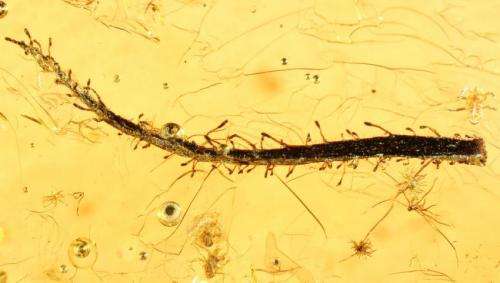December 2, 2014 report
Leaves of ancient carnivorous plants found in Baltic amber

(Phys.org)—A team of researchers affiliated with several institutions in Germany has discovered samples of two types of carnivorous plants that apparently date from the Eocene, embedded in Baltic amber. In their paper published in Proceedings of the National Academy of Sciences, the team describes the plant leaves and offers opinions on their possible ties to modern carnivorous plants.
The amber was part of a trove that has been found in a mine near Kaliningrad, Russia, where tons of samples have been taken over the past couple hundred years. The researchers obtained their samples from a pair of German amber collectors. Embedded inside two pieces of amber the researchers found leaves from what they believe to be the oldest known examples of a carnivorous plant.
The researchers believe the leaves date back approximately 35 to 47 million years ago, a time when Europe was warmer than today and still isolated from Asia. The find is rare, the team notes, as plants doesn't fossilize well. They think the original plants might be part of the Roridulacea family of carnivorous plants, which of course includes Roridula, which lives in modern times in South Africa. While technically a carnivore, the Roridual (and likely the newly found fossils) don't actually eat other creatures, instead they capture insects with sticky leaves and then wait for other insects to come by and eat them. The plant gets its nourishment from the excrement left by the bigger insects.
The team reports that the leaves were very well preserved and very different from other flowering plants—they have tentacley hairs which are believed to have exuded sticky fluid. They're also very small, just five millimeters long. They suggest the original plant likely had larger leaves as well, but can't say for certain. The leaves also offer no clues as to how big the plant might have been. Larger leaves (and bugs, animals, etc.) don't tend to become trapped in tree resin, they note, which means modern scientists have very little to work with when attempting to reconstruct conditions from so long ago.
The research was part of a larger ongoing effort to better understand the early history of the area which led to so much amber being produced. They want to know, for example, if it was dense forest or woodlands with the occasional meadow.
More information: Carnivorous leaves from Baltic amber, Eva-Maria Sadowski, DOI: 10.1073/pnas.1414777111
Abstract
The fossil record of carnivorous plants is very scarce and macrofossil evidence has been restricted to seeds of the extant aquatic genus Aldrovanda of the Droseraceae family. No case of carnivorous plant traps has so far been reported from the fossil record. Here, we present two angiosperm leaves enclosed in a piece of Eocene Baltic amber that share relevant morphological features with extant Roridulaceae, a carnivorous plant family that is today endemic to the Cape flora of South Africa. Modern Roridula species are unique among carnivorous plants as they digest prey in a complex mutualistic association in which the prey-derived nutrient uptake depends on heteropteran insects. As in extant Roridula, the fossil leaves possess two types of plant trichomes, including unicellular hairs and five size classes of multicellular stalked glands (or tentacles) with an apical pore. The apices of the narrow and perfectly tapered fossil leaves end in a single tentacle, as in both modern Roridula species. The glandular hairs of the fossils are restricted to the leaf margins and to the abaxial lamina, as in extant Roridula gorgonias. Our discovery supports current molecular age estimates for Roridulaceae and suggests a wide Eocene distribution of roridulid plants.
Journal information: Proceedings of the National Academy of Sciences
© 2014 Phys.org





















